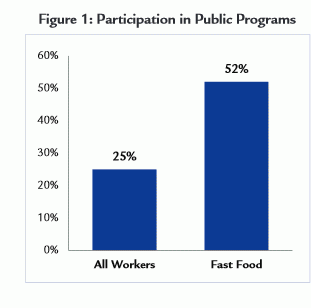INSTITUTE INDEX: The high public cost of fast-food jobs

Sales generated last year by the U.S. fast-food industry: $200 billion
Percent of families of front-line fast-food workers employed full-time that are enrolled in public assistance programs: more than 50
Factor by which that exceeds the U.S. workforce as a whole: 2
Annual cost of public assistance to families of fast-food workers: nearly $7 billion
Annual cost of public assistance to families of McDonald's workers alone: $1.2 billion
McDonald's net income last year: $5.5 billion
Compensation last year for McDonald's CEO: $13.7 million
Annual spending on food stamp benefits for fast-food workers and their families: $1.04 billion
Percent of fast-food workers' families that receive food stamps in Tennessee, the state with the highest rate: 42
Percent of fast-food workers who get health benefits through their employer: 13
Percent of the U.S. workforce as a whole that gets health benefits through their employer: 59
Annual spending on Medicaid and the Children's Health Insurance Program for the families of fast-food industry workers: $3.9 billion
Median hourly wage for the U.S. workforce as a whole: $16.57
Median hourly wage for front-line fast-food jobs: $8.69
Percent of front-line fast-food workers who are Latino: 20
Who are African-American: 23
Who are women: 73
Number of cities across the U.S. where fast food workers went on a day-long strike in August to call for a $15 hourly wage and the right to unionize without retaliation: 60
(Click on figure to go to source. Most of the numbers in this index come from "Fast Food, Poverty Wages: The Public Cost of Low-Wage Jobs in the Fast-Food Industry," an October 2013 report sponsored by the University of California, Berkeley's Center for Labor Research and Education and the University of Illinois Urbana-Champaign Department of Urban & Regional Planning, with funding provided by Fast Food Forward.)
Tags
Sue Sturgis
Sue is the former editorial director of Facing South and the Institute for Southern Studies.
